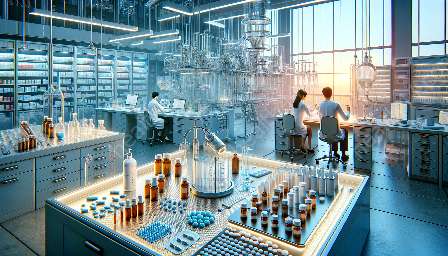In the field of pharmaceutical development, the processes of quality control and assurance are of paramount importance, as they directly impact drug safety, efficacy, and ultimately, patient well-being. Quality control and assurance involve a series of rigorous measures and standardized practices to ensure that pharmaceutical products comply with established quality standards, regulatory requirements, and are safe for consumption.
Pharmaceutical technology and dosage form design play a crucial role in the development of safe and effective drug products. These areas encompass various aspects of drug formulation, manufacturing, and delivery systems, all of which have a direct impact on the quality and performance of pharmaceutical products.
The Role of Quality Control and Assurance
Quality control and assurance in pharmaceutical development are multidimensional processes that begin with the selection and qualification of raw materials, followed by rigorous testing and analysis at every stage of drug manufacturing and formulation. This ensures that the end product meets the required standards of identity, strength, purity, and quality.
Adherence to current Good Manufacturing Practices (cGMP) is essential in ensuring the consistent quality of pharmaceutical products. Quality control measures include thorough testing for impurities, stability, dissolution rates, and bioavailability, among other parameters, to guarantee the safety and efficacy of the final drug product. These measures are critical in preventing issues such as sub-potent or super-potent medications, contamination, or adulteration.
Ensuring Drug Efficacy and Safety
Pharmacy professionals play a pivotal role in ensuring that pharmaceutical products meet the required quality standards before they reach the hands of patients. Pharmacists are tasked with verifying the quality and authenticity of medications, compounding and dispensing medications accurately, and providing patients with essential information regarding medication use and potential side effects.
The connection between quality control and assurance and pharmacy underscores the importance of maintaining a reliable and safe drug supply chain. By adhering to quality standards and regulatory requirements, pharmacy professionals contribute to minimizing the risk of medication errors, adverse reactions, and therapeutic failure.
Integration of Technology and Design in Quality Control
Technological advancements have revolutionized the field of quality control and assurance in pharmaceutical development. Automated systems for testing and analysis, such as high-performance liquid chromatography (HPLC) and mass spectrometry, allow for precise and efficient evaluation of drug products, ensuring that they meet stringent quality specifications.
Furthermore, dosage form design heavily relies on pharmaceutical technology to develop innovative drug delivery systems that encapsulate the active pharmaceutical ingredient (API) in a manner that ensures optimal bioavailability and therapeutic efficacy. Factors such as particle size distribution, polymorphism, and solid-state properties are all critical considerations in the design and manufacturing of dosage forms, ultimately impacting the product's quality and performance.
Regulatory Compliance and Quality Assurance
Regulatory bodies such as the Food and Drug Administration (FDA) and the European Medicines Agency (EMA) play a pivotal role in setting and enforcing stringent quality standards for pharmaceutical products. These organizations oversee the approval, manufacturing, and distribution processes to ensure that drugs meet the necessary quality, safety, and efficacy criteria before they are made available to the public.
Effective quality control and assurance are instrumental in achieving and maintaining regulatory compliance. By implementing robust quality management systems and adhering to regulatory guidelines, pharmaceutical companies can demonstrate their commitment to producing high-quality, safe, and effective medications, ultimately safeguarding public health.
Conclusion
The intricate interplay between quality control and assurance, pharmaceutical technology, dosage form design, and pharmacy underscores the critical importance of these factors in the development and delivery of safe and effective pharmaceutical products. By upholding the highest quality standards, pharmaceutical developers, manufacturers, and pharmacists collectively contribute to enhancing patient outcomes and public health.


